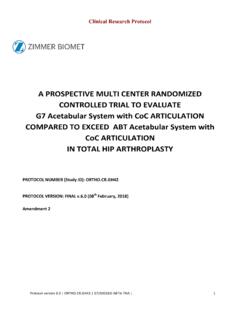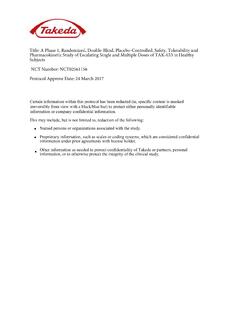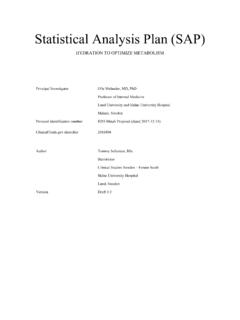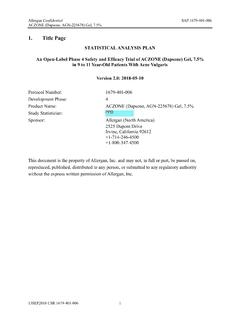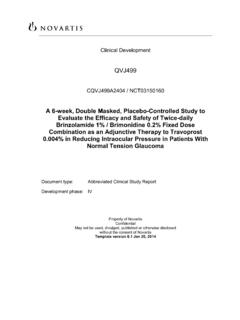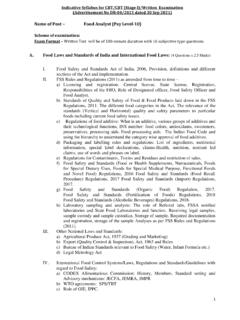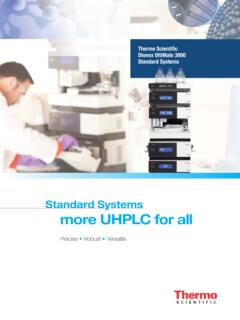Transcription of Clinical Pharmacokinetic Noncompartmental Data Analysis Plan
1 - i - PRIVILEGED AND CONFIDENTIAL COMMUNICATION Clinical RESEARCH IN INFECTIOUS DISEASES Clinical Pharmacokinetic Noncompartmental Data Analysis Plan For DMID Protocol: 16-0118 Study Title: A Phase 1 Clinical Trial to Evaluate the Plasma Pharmacokinetics, Safety, and Tolerability of a Single Oral Dose of Zoliflodacin in Healthy Male and Female Subjects Version DATE: 03 April 2018 Prepared and Distributed by: The Emmes Corporation Rockville, Maryland USA THIS COMMUNICATION IS PRIVILEGED AND CONFIDENTIAL The Emmes Corporation Version Noncompartmental Pharmacokinetic Analysis Plan DMID Protocol: 16-0118 03 April 2018 - ii - PRIVILEGED AND CONFIDENTIAL COMMUNICATION TABLE OF CONTENTS ACRONYMS AND ABBREVIATIONS.
2 III 1. PREFACE ..1 2. Clinical STUDY METHODS ..2 Analysis Groups ..2 Dose Administration ..2 PK Sampling Schedule ..2 Analytical Methods ..2 Collection of Pharmacodynamic or Clinical Endpoints ..2 3. Pharmacokinetic Analysis METHODS ..3 Analysis Population and Handling of Missing Time Points ..3 Demographic and Baseline Characteristics ..3 Dosing and Pharmacokinetic Sampling Summary ..3 Definition and Estimation of Individual NCA PK Parameters ..4 Descriptive Statistics ..6 Reporting Conventions ..6 4. REFERENCES ..7 5. LISTING OF PROPOSED TABLES, FIGURES, AND LISTINGS ..8 6. APPENDICES ..9 APPENDIX 1.
3 LIST OF PROPOSED PK TABLES ..10 APPENDIX 2. LIST OF PROPOSED PK FIGURES ..14 APPENDIX 3. LIST OF PROPOSED PK LISTINGS ..19 The Emmes Corporation Version Noncompartmental Pharmacokinetic Analysis Plan DMID Protocol: 16-0118 03 April 2018 - iii - PRIVILEGED AND CONFIDENTIAL COMMUNICATION ACRONYMS AND ABBREVIATIONS Standard acronyms and abbreviations are listed below. Abbreviation Definition AUC Area Under the Concentration-Time Curve AUC(0-last) AUC to the Last Measurable Concentration AUC(0-t) AUC from 0 to time t AUC(0- ) AUC Extrapolated to Infinity BMI Body mass Index BQL Below the Quantification Limit Clast Last Measurable Concentration (above the quantification limit) CL/F Apparent Oral Clearance cm Centimeter(s) Cmax Maximum Plasma Concentration CSR Clinical Study Report CV Coefficient of Variation EDC Electronic Data Capture g Gram(s) GM Geometric Mean GSD Geometric Standard Deviation h Hour(s)
4 HPLC-MS/MS High-Performance Liquid chromatography with tandem mass spectrometry Ke Terminal Phase Elimination Rate Constant kg Kilogram(s) L Liter(s) LLOQ Lower Limit of Quantification Max Maximum Min Minimum min Minute(s) mL Milliliter(s) NCA Noncompartmental Analysis ng Nanogram(s) PK Pharmacokinetic (s) SD Standard Deviation t1/2 Apparent Terminal Elimination Half-Life Tlast Time of Last Measurable Concentration Tmax Time to Maximum Plasma Concentration (Cmax) Vz/F Apparent Volume of Distribution During Terminal Phase The Emmes Corporation Version Noncompartmental Pharmacokinetic Analysis Plan DMID Protocol: 16-0118 03 April 2018 - 1 - PRIVILEGED AND CONFIDENTIAL COMMUNICATION 1.
5 PREFACE DMID protocol 16-0118 is a Phase 1 study of zoliflodacin in healthy male and female subjects. The pharmacokinetics (PK)-related objectives of the study are: To evaluate the plasma PK of zoliflodacin after administration of a single 4 g oral dose under fasting conditions This document reiterates key PK elements in the study design of DMID Protocol 16-0118 and thoroughly describes the presentations and summaries of PK data as well as the Noncompartmental Analysis (NCA) to be included in the PK Report and summarized in the Clinical study report (CSR) for this protocol. Shells and mockups are given for all PK-related tables, figures, and listings planned for inclusion in the CSR and/or PK Report.
6 At minimum, mean PK plots as well as listings and summaries of zoliflodacin concentrations and PK parameters will be included in the CSR, while all tables, figures, and listings described in this document will be included in the PK Report. The Emmes Corporation Version Noncompartmental Pharmacokinetic Analysis Plan DMID Protocol: 16-0118 03 April 2018 - 2 - PRIVILEGED AND CONFIDENTIAL COMMUNICATION 2. Clinical STUDY METHODS Analysis Groups This is a Phase 1, open-label Clinical trial of a single 4 g oral dose of zoliflodacin after an overnight fast. Eight healthy subjects who consent to participate in the trial and meet the eligibility criteria will be enrolled into a single cohort.
7 Stratification will not be used in this study. All subjects will be analyzed in a single Analysis group and no comparisons will be performed. Dose Administration Eligible subjects will receive a single 4 g dose (2 sachets of 2 g of zoliflodacin reconstituted on the same day and administered in a total of ) orally after an overnight fast. The dose will be administered in a standardized cup. After the of zoliflodacin is administered, an additional will be added to the same cup and consumed by the subject to chase the initial dose. Both doses will be completed within a total of 5 min. After dosing, subjects will continue to fast for an additional 4 h while water is allowed ad lib.
8 PK Sampling Schedule Blood (plasma) samples will be collected into K2 EDTA tubes at the following time points: On Day 1 at 30 min before dosing, and h ( 5 min), 1 h ( 5 min), 2 h ( 5 min), 3 h ( 10 min), 4 h ( 10 min), 6 h ( 10 min), 8 h ( 15 min), and 12 h ( 15 min) after dosing; on Day 2 at 24 h ( 2 h) and 36 h ( 2 h) after dosing; on Day 3 at 48 h ( 2 h) after dosing; and on Day 4 at 72 h ( 2 h) after dosing, or early termination. Analytical Methods Plasma concentrations of zoliflodacin will be determined using a validated HPLC-MS/MS method. The Analysis will be performed by KCAS Bioanalytical Services. Details are included in the assay validation.
9 For details of sample collection, processing, storage, transportation, and bioanalysis, see the protocol, MOP, and assay validation documents. Collection of Pharmacodynamic or Clinical Endpoints Not applicable. The Emmes Corporation Version Noncompartmental Pharmacokinetic Analysis Plan DMID Protocol: 16-0118 03 April 2018 - 3 - PRIVILEGED AND CONFIDENTIAL COMMUNICATION 3. Pharmacokinetic Analysis METHODS Analysis Population and Handling of Missing Time Points All subjects who received the study drug and who have at least one measurable drug concentration post-dosing will be included in the PK Analysis population.
10 Additionally, there will be a PK Analysis subset, which includes all subjects who completed the PK part of the trial without any protocol violations or deviations that would likely affect the PK results and who have evaluable plasma concentration data for zoliflodacin from which at least the Cmax and Tmax can be determined (peak concentration and at least one decreased concentration after the peak observed). Zoliflodacin concentrations will be listed and shown graphically as individual profiles for all subjects in the PK Analysis population, but concentration summary statistics, mean PK profiles, and NCA will use the PK Analysis subset only.


